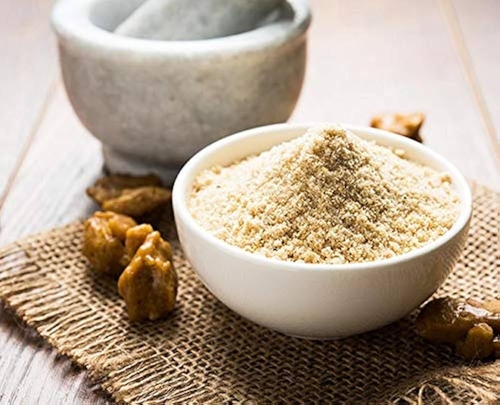Asafoetida (Hing) is a pungent spice derived from the resin of the Ferula plant, native to Iran and Afghanistan but widely used in Indian cuisine. It has a strong sulfurous smell, similar to garlic and onions, but when cooked, it imparts a savory, umami-rich flavor.
It is a type of giant fennel plant native to Iran, Afghanistan, and parts of Central Asia. It has been used for centuries in cooking and traditional medicine due to its strong aroma and various health benefits.
Uses:
-
Cooking: Common in Indian, Middle Eastern, and Persian dishes, especially in dals, curries, and pickles.
-
Ayurveda: Used for digestion, bloating, and respiratory issues.
-
Substitute for Onion & Garlic: Often used in Jain and Brahmin vegetarian diets.
Culinary Uses of Asafoetida
Asafoetida is an essential spice in Indian, Middle Eastern, and Persian cuisines. Despite its pungent raw smell, when cooked, it imparts a deep umami flavor similar to garlic and onions.
Health Benefits of Asafoetida
Beyond its culinary use, asafoetida is valued for its medicinal properties. In Ayurveda and traditional medicine, it is known for:
-
Aiding digestion: Reduces bloating, gas, and indigestion.
-
Anti-inflammatory properties: Helps with respiratory issues like asthma and bronchitis.
-
Antimicrobial effects: Used to prevent infections and boost immunity.
-
Menstrual health: Helps in relieving menstrual cramps and irregular cycles.
-
Mood booster: Traditionally used to alleviate stress and anxiety.
There are mainly two types of Asafoetida (Hing), classified based on their processing and form:
-
Raw Asafoetida (Ferula Asafoetida Resin)
-
This is the pure, unprocessed form, which appears as a gum resin.
-
It is extremely strong in odor and taste.
-
Used in traditional medicine and some specialty cooking.
-
-
Compounded Asafoetida (Hing Powder/Paste)
-
This is the commonly available form in markets.
-
It is mixed with edible starch (like wheat or rice flour) and gum Arabic to make it easier to use.
-
Comes in powder or block form.
-
Regional Varieties:
Asafoetida is mainly produced in Afghanistan, Iran, and India, and it has different varieties based on origin and quality:
-
Hing Kabuli Sufaid (Milky White Asafoetida) – Milder in flavor, mostly used in Indian cooking.
-
Hing Lal (Red/Brown Asafoetida) – Stronger and darker, used in medicinal applications.
There are also 2 types of Hing: Bitter hing and sweet hing.
Bitter Hing and Sweet Hing are two categories of Asafoetida based on their taste profile and chemical composition.
Bitter Hing
-
🔸 More common type of Asafoetida.
-
🔸 Strong, pungent aroma and sharp, bitter taste.
-
🔸 Contains higher sulfur compounds (like ferulic acid and disulfides), giving it a more intense flavor.
-
🔸 Mainly used in Indian, Middle Eastern, and Ayurvedic medicine.
-
🔸 Used in tempering (tadka), pickles, and medicinal formulations.
-
🔸 Examples: Hing Kabuli Sufaid, Hing Lal (Red Hing).
Sweet Hing
-
🔹 Milder in taste and aroma compared to bitter Hing.
-
🔹 Contains less sulfur compounds, making it less pungent.
-
🔹 Sometimes blended with starch or natural sweeteners to tone down the bitterness.
-
🔹 Used in mild-flavored dishes, sauces, and Ayurvedic remedies.
-
🔹 Found in some premium or specialty Hing varieties.
it also comes in different forms, each with its own unique properties and uses. Below, we explore the main types of Hing, including Nukra Hing and Pasty Hing, and how they compare to other varieties.
There are different types of Asafoetida categorized based on their texture and processing: Nukra Hing, Pasty Hing, Dried, Hadda Hing and XL Hing.
1. Nukra Hing (Granular Hing)
After making the first cut on the stump of Asafoetida plant, a resin with low concentration and impurity. which has higher percentage of fat and essential oil oozes out.
-
This is a semi-solid or crystalline form of Asafoetida.
-
It looks like small granules or lumps and is less processed than the powdered variety.
-
Typically, higher quality and more potent than regular powdered Hing.
-
Needs to be crushed or dissolved before use in cooking.
2. Pasty Hing (Paste-like Hing)
Pasty Hing is a moist, soft, and sticky form of Asafoetida that retains its pure resinous texture. Unlike powdered Hing, which is mixed with flour or gum, Pasty Hing is closer to its natural form, making it more potent and aromatic. This resin is thicker and the amount of essential oil and fat is less.
-
This is a moist, soft, and sticky form of Asafoetida.
-
It is usually a higher concentration of pure resin with minimal additives.
-
Known for its strong, pungent aroma and medicinal properties.
-
Often used in traditional remedies and some South Indian or Ayurvedic preparations.
- Types of pasty hing in Iran are: 1-Pinexir hing, 2-Hingra hing, 3-Irani Ras hing, 4-Perungayam Brown Cake Asafoetida.
-
Pinixer Hing: Pinexir Hing is a variety of raw asafoetida (hing) and pasty hing. It's known for its potent aroma and flavor, making it a preferred choice in both household cooking and various industries. Here are some information about this product:
-
Botanical name
Peernexir
Asafoetida
Hindi name
Tala Hing
Form
Liquid
Color
White (Milky)
Taste
Spicy
Oil Content
Present
Organic
Yes
Origin
Iran
Hingra Hing: Hingra Hing is a variety of asafoetida distinguished by its darker color and oil-soluble properties. It is primarily sourced from the species Ferula foetida and is considered less aromatic compared to the lighter-colored, water-soluble Hing variety, which is derived from species like Ferula assa-foetida and Ferula alliacea.
|
Hindi name |
Hingra |
|
Benefits |
Digestion |
|
Organic |
Yes |
|
Origin |
Iran |
Irani Ras Hing: Irani Ras Hing refers to a specific type of asafoetida (hing) sourced from Iran, known for its potent aroma and flavor. The term "Ras" indicates that this hing is in a liquid or semi-liquid form, distinguishing it from the more common solid or powdered varieties. This form is often preferred in certain culinary and industrial applications due to its concentrated nature.
Key Characteristics of Irani Ras Hing:
-
Origin: Sourced from Iran, a region renowned for producing high-quality asafoetida.
-
Form: Typically available in liquid or semi-liquid form, making it suitable for specific uses in food production and traditional recipes.
-
Usage: Commonly utilized in the preparation of pickles, spice blends, and various savory dishes to enhance flavor and aroma.
|
Hindi name |
Irani Ras hing |
|
Color |
Brownish |
|
form |
Liquid or semi-liquid |
|
Organic |
Yes |
|
Origin |
Iran |
Perungayam Brown Cake Asafoetida:
Perungayam Brown Cake Asafoetida refers to a specific form of asafoetida, commonly known as "hing" in Hindi and "perungayam" in Tamil. This variety is characterized by its brown color and solid cake form, distinguishing it from other types such as powders or granules.
Key Characteristics:
-
Form: Compressed into solid cakes, which can be broken into smaller pieces or ground into powder as needed.
-
Color: Brown, indicating a particular processing method or source.
-
Aroma and Flavor: Possesses a strong, pungent aroma and flavor, typical of asafoetida, which mellows upon cooking to impart a savory depth to dishes.
Culinary Uses:
In Indian cuisine, Perungayam Brown Cake Asafoetida is often used in tempering, especially in lentil dishes, curries, and pickles. A small piece is typically fried in hot oil to release its flavors before adding other ingredients.
Storage Recommendations:
To maintain its potency and prevent its strong
aroma from permeating other items, it's advisable to store asafoetida in an airtight container, placed within another sealed container.
Continue
view more


 تمام شد
تمام شد